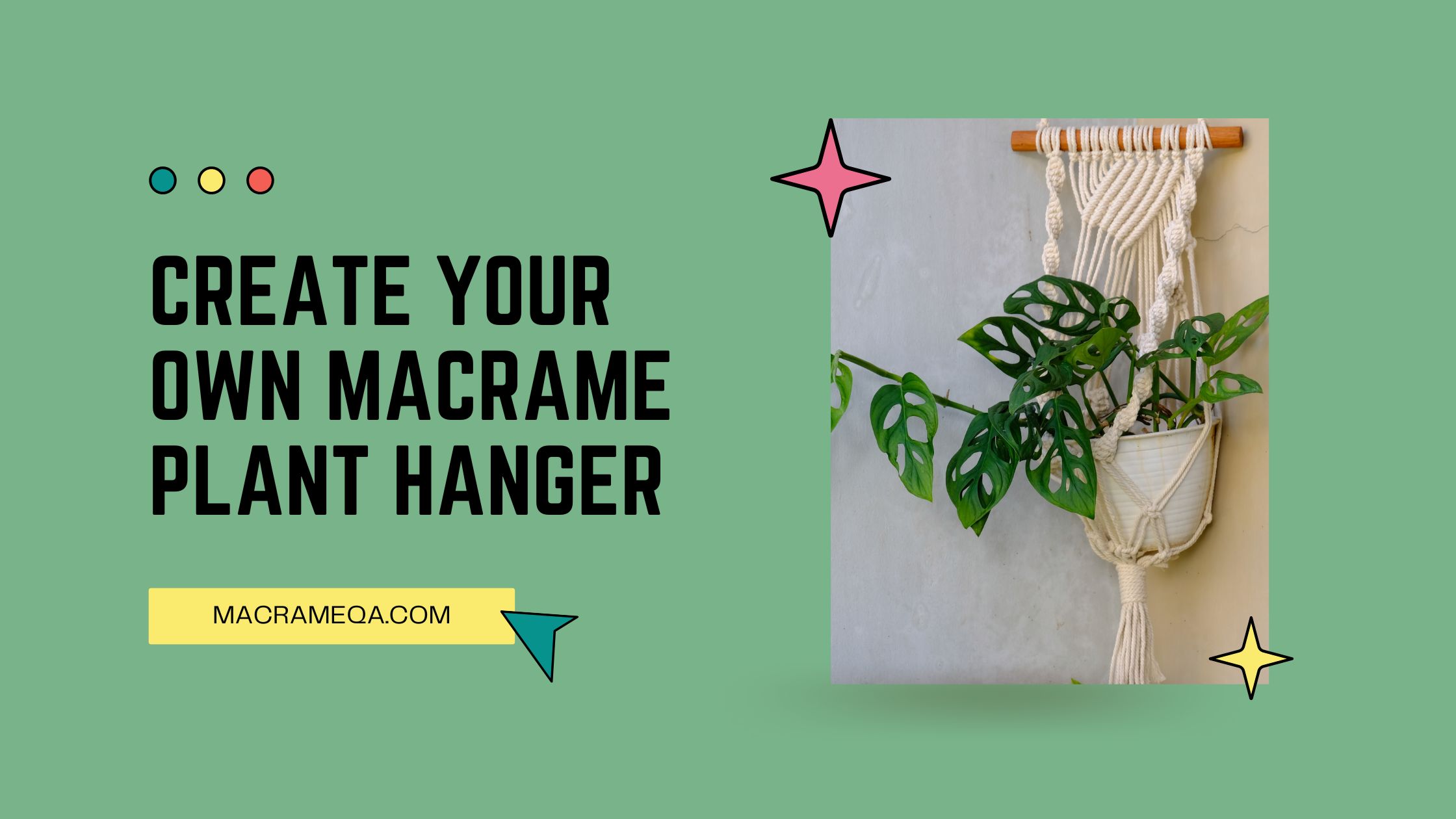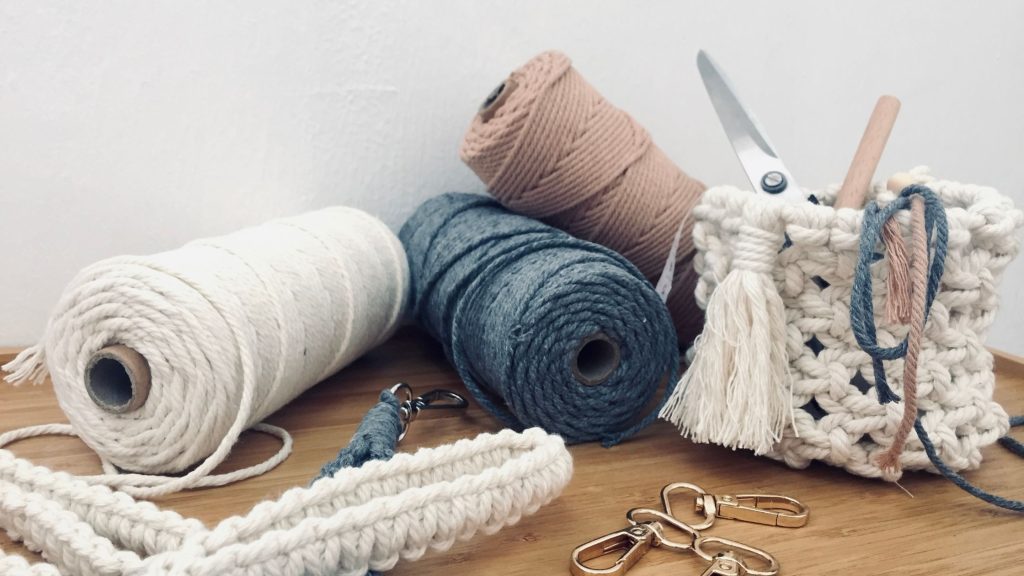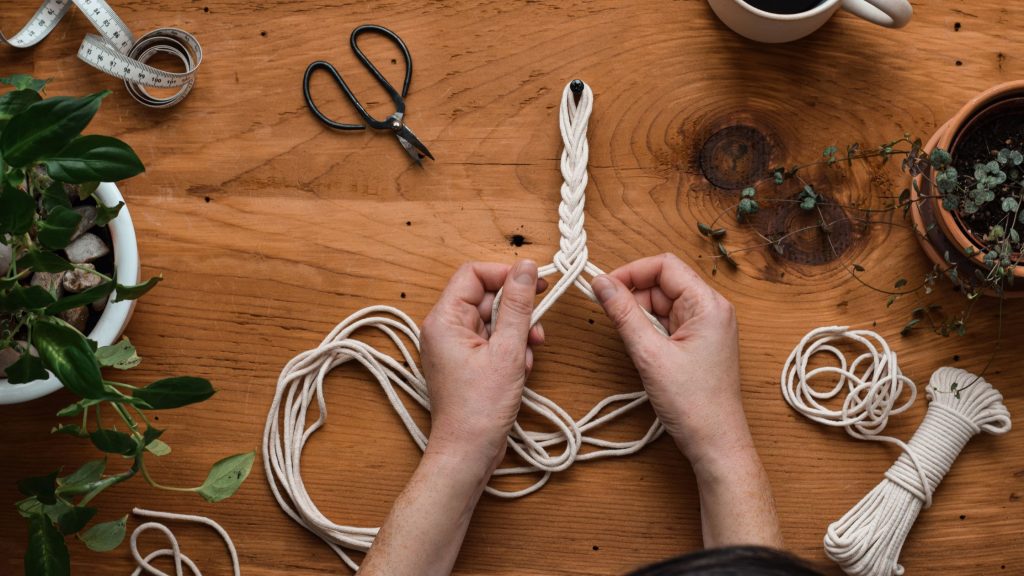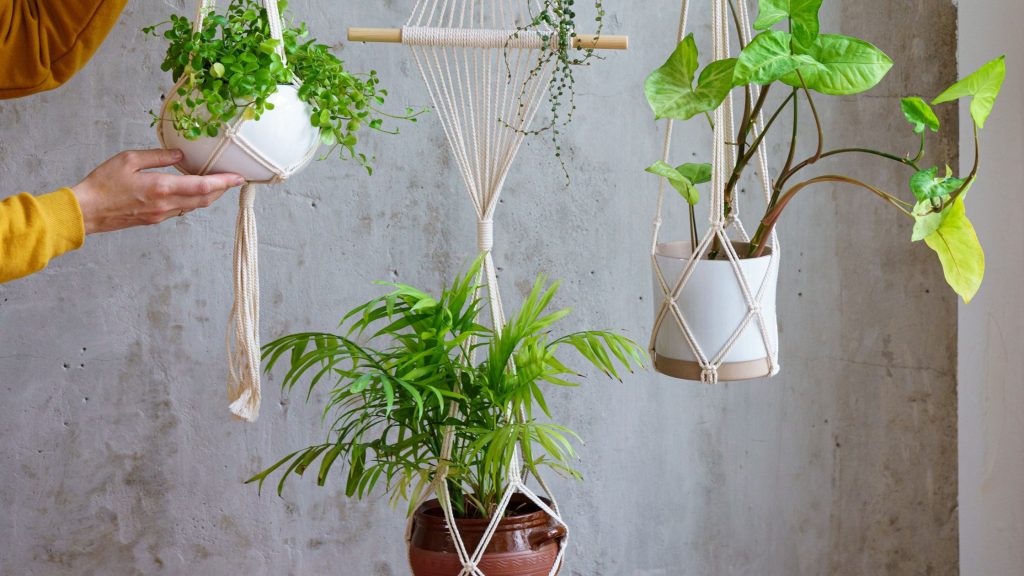Embark on a new creative journey and learn how to create your own macramé plant hanger with this easy-to-follow guide. Macramé, the art of knotting cord in patterns to create decorative pieces, has been regaining popularity in recent years and is a fun and rewarding craft. Not only will you be able to showcase your greenery in a unique and stylish way, but creating your own macramé plant hanger also allows you to personalize it to fit your own space and style.
Follow the step-by-step instructions and illustrations in this guide to create a beautiful and functional piece of home décor that will impress your friends and family. With some practice and patience, you’ll have a gorgeous macramé plant hanger that adds a touch of bohemian chic to any room in no time. So, gather your materials and let’s get started on this creative project!
Key Takeaways:
- Macramé Plant Hanger: Creating your own macramé plant hanger allows you to customize the design to fit your style and the specific needs of your plants.
- Materials and Tools: Understanding the materials and tools needed for macramé plant hangers is crucial for a successful project. Be sure to gather all necessary supplies before starting.
- Basic Knots: Learning the basic knots used in macramé, such as the square knot and the half hitch knot, will be essential in creating a strong and attractive plant hanger.
- Measurement and Design: Taking accurate measurements and planning the design layout beforehand will ensure a well-proportioned and aesthetically pleasing macramé plant hanger.
- Finishing Touches: Adding finishing touches, such as decorative beads or fringes, can elevate the look of your macramé plant hanger and make it truly unique.
Understanding the Basics of Macramé
Obviously, before you dive into creating your own macramé plant hanger, it’s crucial to understand the basics of macramé. This ancient craft has gained popularity in modern times for its beautiful and intricate designs using knotting techniques.
Definition and History
One of the earliest forms of knotting, macramé originated in the 13th century in Arabia. It spread to Europe through Moorish conquest and became popular during the Victorian era. Macramé involves creating textiles using knotting techniques rather than weaving or knitting.
One of the key features of macramé is its versatility, allowing for a wide range of designs including wall hangings, plant hangers, and jewelry. This craft has evolved over the centuries, with modern macramé artists combining traditional techniques with contemporary styles to create stunning, one-of-a-kind pieces.
Fundamental Knots and Techniques
With a few basic knots and techniques, you can create intricate macramé designs. The fundamental knots include the square knot, half hitch knot, and lark’s head knot. These knots form the foundation of macramé and can be combined in various ways to create different patterns and textures.
Definition: Understanding these fundamental knots and techniques is essential for mastering macramé and creating your own unique designs. Whether you’re a beginner or experienced crafter, honing your knotting skills will open up a world of possibilities for your macramé projects.
Materials Needed for Your Macramé Plant Hanger
Assuming you’re ready to tackle the task of creating your own beautiful macramé plant hanger, you’ll need to gather a few essential materials to get started. To ensure you have everything you need, follow this Simple DIY Macrame Plant Hanger tutorial to guide you through the process.
Types of Cords and Their Properties
With macramé plant hangers, the type of cord you use is crucial to the overall look and durability of the finished product. When selecting cords, consider the properties of each option. Some popular choices include cotton, jute, nylon, and polyester. These cords vary in thickness, strength, and texture, so it’s important to choose one that aligns with your desired look and feel. Perceiving the differences in these cord types will help you make an informed decision about which one is best for your project.
| cotton | durable and soft |
| jute | natural and textured |
| nylon | strong and resistant to mold |
| polyester | smooth and weather-resistant |
Selecting the Right Beads and Accessories
One of the ways to add personality to your macramé plant hanger is by incorporating beads and accessories. Beads can add visual interest and a pop of color, while accessories like rings and hooks can enhance the functionality and style of your hanger. Consider the aesthetic you want to achieve and choose beads and accessories that complement your vision. It’s essential to take your time selecting the right beads and accessories to ensure they align with the overall design of your plant hanger.
It’s important to consider the size, shape, and material of the beads, as well as the functionality and durability of the accessories. Paying attention to these details will result in a cohesive and visually appealing macramé plant hanger that meets your standards.
Choosing the Perfect Plant and Pot
The type of plant and pot you choose for your macramé hanger can greatly impact the overall look and feel of the finished product. The size and weight of the plant and pot will also influence the strength and length of your cords. The combination of a lush green plant and a stylish pot can enhance the aesthetic appeal of your macramé plant hanger, so it’s important to choose wisely. To create a balanced and visually pleasing display, consider the overall size and shape of the plant and pot in relation to the design of your hanger.
To ensure the longevity and health of the plant, it’s crucial to select a species that thrives in your indoor environment and can be adequately supported by the macramé hanger. Additionally, the choice of pot should provide ample support and drainage for the plant while complementing the style of your hanger. Taking these factors into consideration will help you create a harmonious and sustainable display for your space.
Preparing Your Workspace
After deciding to make your own macramé plant hanger, it’s time to prepare your workspace. Creating a comfortable and well-organized environment is essential for a smooth crafting experience. In this chapter, we will guide you through the process of setting up your workspace and organizing your materials.
Essential Tools for Macramé
One of the most important steps in preparing your workspace is gathering all the necessary tools for macramé. To get started, you will need a pair of sharp scissors, a tape measure, and macramé cord in your desired color. Additionally, a macramé board or mounting device can be helpful for keeping your work steady as you create intricate knots.
Setting Up a Comfortable Workspace
On top of having the right tools, it’s important to set up a comfortable workspace that promotes good posture and ease of movement. Ensure that your chair provides ample support for your back, and that your workspace is well-lit to prevent eye strain. Having a clean and clutter-free area will also help you focus on your craft without any distractions.
Workspace organization, good lighting, and supportive seating are all essential components of a comfortable workspace. By prioritizing these factors, you can create an environment that is conducive to macramé crafting and enhance your overall experience.
Tips for Organizing Materials
Tools and materials for macramé can quickly become tangled and disorganized if not properly managed. To avoid frustration, consider implementing the following tips for organizing your materials:
- Use small containers or bins to store different types of cord separately.
- Label each container to easily identify the materials you need.
- Keep a dedicated space for your macramé board or work surface to avoid misplacing it.
For instance, by utilizing small containers and labeling them accordingly, you can streamline the process of finding the materials you need for your macramé project. Any method that helps you keep your tools and materials organized will ultimately save you time and frustration in the long run.
Step-by-Step Guide to Making a Basic Macramé Plant Hanger
Now, if you’re looking to add a touch of boho-chic style to your living space, creating your own macramé plant hanger is a great place to start. And what’s even better is that it’s easier than you think! For a detailed tutorial, check out this DIY Macrame Plant Hanger Tutorial – Bathroom Makeover for step-by-step instructions. Here’s a breakdown of the process:
Measuring and Cutting the Cords
Cutting the cords to the right length is crucial for creating a balanced and aesthetically pleasing macramé plant hanger. Measure and cut the cords according to the specifications in the tutorial, ensuring that they are all uniform in length. This will provide a sturdy foundation for your plant hanger.
Starting Your Plant Hanger with Gathering Knots
Measuring the length of the cords and gathering them at the top is the first step in creating your macramé plant hanger. This is where you’ll establish the starting point for the rest of the knots and patterns. Plus, it sets the tone for the overall design and structure of the hanger.
Plus, take your time with this step to ensure accuracy and precision, as it will lay the groundwork for the entire project.
Creating the Framework with Square Knots
Hanger Once you’ve gathered the cords and established the top of your plant hanger, it’s time to create the framework using square knots. This is where the intricate patterns and designs start to take shape, giving your plant hanger a unique and eye-catching look. Any mistakes or inconsistencies in this step can affect the overall appearance and stability of the hanger.
Any deviations from the tutorial’s instructions can result in an unbalanced and potentially unsafe plant hanger, so it’s important to follow the guidance closely.
Adding Decorative Touches with Beads and Knots
One of the fun parts of creating a macramé plant hanger is adding decorative touches with beads and knots. This is where you can let your creativity shine and customize your hanger to fit your personal style. Basic bead and knot arrangements can elevate the aesthetic appeal of your plant hanger, making it stand out as a unique piece in your home.
Securing Your Plant Pot with Wrapping Knots
Beads Once you’ve completed the main body of the hanger, it’s essential to secure your plant pot with wrapping knots. This step ensures that your plant will be safely and securely supported within the hanger, preventing any mishaps or accidents. Pay close attention to this step, as it directly impacts the safety and stability of the final product.
Touches It’s important to reinforce the wrapping knots to provide extra support and peace of mind.
Design Variations and Personal Touches
Unlike some other crafts, macramé allows for a wide range of design variations and personal touches. This means that you can truly make your macramé plant hanger your own, and incorporate your own style and preferences into the design.
Exploring Different Knotting Patterns
Exploring different knotting patterns is a great way to add unique flair to your macramé plant hanger. You can experiment with various knots, such as the square knot, half hitch knot, or lark’s head knot, to create intricate designs and textures. Consider mixing different knotting patterns to create a personalized look that is both visually appealing and structurally sound.
Experimenting with Colors and Textures
The color and texture of your macramé cords can greatly impact the overall look of your plant hanger. The type of cord you choose, whether it’s cotton, jute, or nylon, will affect the texture of your piece. You can also experiment with dip-dyeing or ombré techniques to add a pop of color. Play with different color combinations to create a macramé plant hanger that reflects your personal style and complements your home decor.
With careful consideration of the colors and textures, you can create a stunning and visually dynamic macramé plant hanger that will be the focal point of any room.
Adding Complexity with Spirals and Braids
Different spirals and braids can add complexity and visual interest to your macramé plant hanger. By incorporating spiral designs or braided elements, you can elevate the overall look and create a one-of-a-kind piece. These intricate details will showcase your craftsmanship and attention to detail, making your macramé plant hanger stand out.
Design variations such as spirals and braids can bring a unique and eye-catching element to your macramé plant hanger, elevating it from a simple plant holder to a stunning piece of art.
Tips for Perfecting Your Macramé Technique
Your macramé technique can always be improved with practice and attention to detail. Here are some tips to help you perfect your craft:
- Use high-quality, durable materials
- Pay attention to tension to create even and balanced knots
- Practice proper knotting techniques for different patterns
Recognizing the areas where you can improve and being patient with yourself will ultimately lead to mastery of the macramé technique.
Common Mistakes and How to Avoid Them
Common mistakes in macramé include using materials that are too flimsy, inconsistent tension in knots, and misunderstanding knotting techniques. To avoid these errors, it’s important to invest in high-quality materials, pay close attention to the tension of your knots, and practice different knotting techniques to ensure mastery.
Factors Affecting the Quality of Your Macramé
With macramé, factors such as the type of materials used, the level of experience with knotting techniques, and the amount of attention to detail can greatly affect the quality of your final product. Recognizing the impact of these factors is crucial for improving the overall craftsmanship of your macramé plant hanger.
- The type of materials used
- The level of experience with knotting techniques
- The amount of attention to detail
Your dedication to using high-quality materials, honing your skills in knotting and paying attention to detail will ultimately result in the improved quality of your macramé plant hanger.
Care and Maintenance of Macramé Plant Hangers
To ensure the longevity of your macramé plant hanger, it’s important to clean it regularly and avoid exposing it to moisture for extended periods. Additionally, hanging your plant hanger in a protected area will help maintain its integrity over time.
Plus, routinely inspecting the materials and knots for any signs of wear and tear will allow you to address any issues promptly and preserve the quality of your macramé plant hanger.
Showcasing Your Finished Macramé Plant Hanger
Despite the time and effort it took to create your macramé plant hanger, the real joy comes from showcasing your finished piece. Whether you choose to hang it indoors or outdoors, there are endless ways to display your handmade creation and add a touch of bohemian charm to your space.
Ideas for Displaying in Your Home
On a sunny windowsill, your macramé plant hanger can beautifully showcase your favorite indoor plants. You can also hang it from a ceiling hook in any room to add a touch of greenery. If you have a dedicated space for your plants, consider creating a group of macramé hangers at different lengths to create a stunning visual display.
Wrapping and Gifting Your Handmade Creation
The possibilities for wrapping and gifting your handmade macramé plant hanger are endless. The recipient will be delighted to receive such a thoughtful and unique gift. The macramé plant hanger can be a perfect present for any occasion, from housewarming parties to birthdays and holidays.
It can be wrapped in eco-friendly packaging, tied with a rustic twine, and adorned with a sprig of dried lavender or eucalyptus for a personal touch. Remember to include care instructions and tips for hanging the hanger to ensure the recipient can enjoy it for a long time.
Conclusion
Summing up, creating your own macramé plant hanger is a fun and rewarding project that allows you to showcase your creativity and add a touch of bohemian chic to your living space. By following the step-by-step guide provided, you can easily learn the basic macramé knots and techniques needed to construct a simple yet beautiful plant holder. Whether you’re a beginner or an experienced crafter, this DIY activity is a great way to relax and unwind while making something practical and aesthetically pleasing for your home.
With this comprehensive guide, you can confidently embark on your macramé journey and explore the endless possibilities of intricate knot patterns, colorful cords, and stylish plant hangers. So, gather your materials, get started on your macramé project, and enjoy the satisfaction of creating a unique piece of decor that will elevate the look of any indoor space.
FAQ
Q: What is macramé and what is a plant hanger?
A: Macramé is a form of textile-making that uses knotting instead of weaving or knitting. A plant hanger is a decorative way to hang a plant by using macramé techniques to create a holder.
Q: What materials do I need to create a macramé plant hanger?
A: You will need macramé cord, a metal or wooden ring, scissors, and a plant pot or container with a plant. Depending on the design, you may also require beads or additional decorative elements.
Q: Are there different types of knots used in macramé plant hangers?
A: Yes, there are several common knots used in macramé, including the square knot, lark’s head knot, and the half hitch knot. These basic knots can be combined and manipulated to create intricate and decorative patterns for your plant hanger.
Q: How long does it take to create a macramé plant hanger?
A: The time it takes to create a macramé plant hanger will vary depending on your level of experience and the complexity of the design. Simple plant hangers can be completed in a few hours, while more intricate designs may take longer.
Q: Can I use different types of cord to create a macramé plant hanger?
A: Yes, you can use various types of cord for your macramé plant hanger, such as cotton, jute, or even nylon. The choice of cord will affect the overall appearance and durability of the plant hanger, so select a type of cord that suits your design and practical needs.















